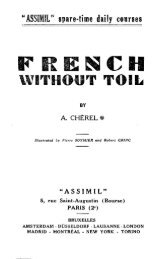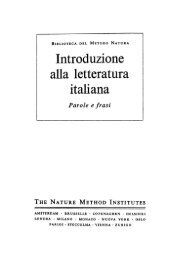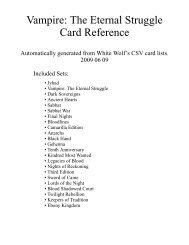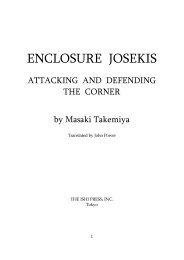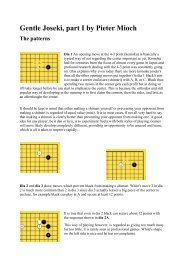Plains Cree: A Grammatical Study - Computer Science Club
Plains Cree: A Grammatical Study - Computer Science Club
Plains Cree: A Grammatical Study - Computer Science Club
Create successful ePaper yourself
Turn your PDF publications into a flip-book with our unique Google optimized e-Paper software.
46 [TRANS. AMER. PHIL. SOC.<br />
WOLFART: PLAINS CREE<br />
But even without this marker, simple conjunct<br />
clauses may express subsequence or purpose; they are<br />
usually introduced by a conjunction like nawac 'it is<br />
better,' e.g., S238-39 . . ., nawac kakwe-wdpamacik.<br />
'you ought to try to see them.'<br />
The simple conjunct is also governed by certain<br />
specific conjunctions such as maywes, pamoyes 'before'<br />
(which may, however, also take the changed con-<br />
junct with preverb ka); tdnika, pitane 'would that!'<br />
etc. Examples: T55p71 maywes pe-sipwehteydhk 'be-<br />
fore we left there'; S8-24 maywes askiy ihtakohk<br />
'before the earth existed'; tdnika kipa takohtet can.<br />
'I wish John would get home soon'; P78-1 pitaneh<br />
pimdtisit! 'May he live!'<br />
5.332. The changed conjunct indicates subordina-<br />
tion in an entirely neutral way. It is the most<br />
versatile, in its syntactic use, of the conjunct modes,<br />
and consequently the most widely used as well.<br />
Initial change may operate on the first syllable of<br />
the verb stem, e.g., S11-31 tekohtet awa kiseyiniw 'when<br />
the old man arrived.' More typically, however, it<br />
affects one of a small set of preverbs (6.521), such as<br />
ki which is changed to kd, e.g., S246-25 eh-pzhtoket,<br />
kd-wdpamdt ohi ka-kih-nipahdt napesisah. 'When she<br />
came in, she saw (3-(3')) the boy (3') whom she had<br />
killed (3-(3')).' The most frequent preverb, e, seems<br />
to be nothing but a "vehicle" for initial change; its<br />
underlying, unchanged form does not occur in <strong>Cree</strong>.<br />
Impressionistically speaking, the use of e is gaining<br />
at the expense of forms where the stem itself undergoes<br />
initial change. Examples: S41-41 papdmitdcimow,<br />
e-nitonawat 'he crawled about, looking for him';<br />
S41-29 kd-pehtamdn e-nikohteyin 'I heard you chop-<br />
ping'; etc.<br />
The uses of conjunct forms may be grouped into<br />
four basic types. While most of these are found<br />
in all conjunct modes, they are most clearly seen in<br />
the changed conjunct.<br />
Narrative: where main and subordinate clause<br />
show no agreement of referents, e.g., P264-32 mwehci<br />
eh-dpihtd-piponiyik, eh-ati-tipiskdyik, wsadmew wiwa.<br />
'Exactly in the middle of winter (0'), at nightfall<br />
(0'), he asked his wife (3') to go with him (3-(3')).'<br />
Participial: where there is some agreement, between<br />
clauses, of overt or covert referents, e.g., S237-5<br />
k-dyztawihkwakanet wihtikow 'the two-faced Windigo';<br />
P262-27 kitimakisindwdw kd-wi-kakwe-nipahiyek.<br />
'You are pitiable (2p) who mean to try to kill me<br />
(2p-l).'<br />
Substantive: where a clause functions as the adjunct<br />
of a verb, e.g., P2-14 kitahtawe peyak kih-pawdtam (3)<br />
e-wih-kapayit (3') moniyaw-iyiniwa (3') wapiski-<br />
-wiyasah (3'). 'Then at one time a certain man<br />
dreamt (3) that the Canadian (3'), the White Man<br />
(3') would land here (3').'<br />
Focal: where the predication is a particle expression,<br />
e.g., P256-19 namoya eh-ahkosiydn. 'It is not that<br />
I am ill'; S40-4 kZtahtawe wdskahikan kah-otihtahk.<br />
'Presently, he came to a house'; P262-10 tanehki k-oh-<br />
picicik? 'Why have they moved camp?'<br />
5.333. The subjunctive mode expresses a condition,<br />
in a very wide sense. For instance, S62-2 kispin<br />
nipahikawiydni, . . . 'if I am slain (indf-1), .. .';<br />
P8-7 nika-pimitdcimon, pihtokeydnih. 'I shall be<br />
crawling along the ground when I enter the lodge.'<br />
The predication on which a subjunctive clause<br />
depends typically (but not obligatorily) contains an<br />
indication of subsequence (futurity), e.g., P8-10<br />
ekwa ki-nipahiyeko, ka-pakocenindwaw. 'And when<br />
you have slain me, you will (ka) cut me open';<br />
S238-3 takwdmoyani ekotj, omisi itwehkan: 'When<br />
you get there, speak then (delayed imperative) thus.'<br />
Finally, subjunctive clauses are often used for<br />
expressing the time of day (cf. 5.334), e.g., P6-34<br />
hdw, tipiskdkih isko nika-pehon. 'Well, I shall wait<br />
until dark.' But note that besides, say, wdpahki 'in<br />
the morning; tomorrow' we also find the changed<br />
conjunct form e-wdpahk with largely the same<br />
meaning.<br />
5.334. The iterative combines not only the morpho-<br />
logical characteristics of the changed and subjunctive<br />
modes, namely initial change and the suffix /ih/, but<br />
also, it would seem, some of their more salient syn-<br />
tactic features: the changed mode's use in participial<br />
and narrative clauses, and the subjunctive's feature of<br />
conditionality.<br />
Examples: S244-19 mistahi miyweyihtamwak mdna<br />
oki oskinikiwak, minisah miyZcitwawi. 'Those young<br />
men were always very glad when they had berries to<br />
eat'; S8-2 kitahtawe mdna sepwehteci, owikimdkana<br />
wawesiyiwa. 'Then presently, whenever he went<br />
away, his wife dressed up.'<br />
Expressions of season often show the iterative (cf.<br />
5.333), e.g., S253-16 niyipiniyikih 'in summer-time';<br />
S254-2 peponiyikih 'in winter-time, every winter.'<br />
5.34. Imperative Order<br />
There are two subcategories, IMMEDIATE and<br />
DELAYED. Imperative forms are used for commands,<br />
exhortations, etc.<br />
The delayed mode indicates that the command,<br />
exhortation, etc. is to be obeyed not immediately but<br />
at a later point in time. Most typically, it is found<br />
together with a conditional clause, e.g., S254-13<br />
. . ." itdhkan, mayaw wdpamacih; '". . ." do you<br />
then say to him, as soon as you see him.' But it is<br />
by no means restricted to such a context; consider<br />
S247-33 haw, awdsis, oma nawaci; micihkahk oma<br />
otakisih. 'Come, child, roast this (immediate); let<br />
us later eat (delayed) this tripe.'<br />
The marker of the delayed imperative is /Lhk/; it<br />
is followed by the same person markers as are found<br />
in the conjunct order. For Proto Algonquian,<br />
Bloomfield (1946: p. 100) sets up a special "prohibi-<br />
tive" order to which the delayed imperative paradigm<br />
of <strong>Cree</strong> would correspond.



